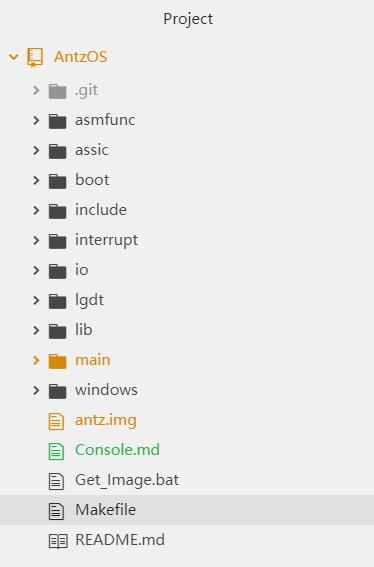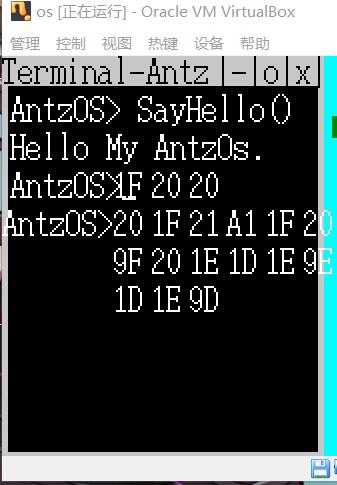I've standardized the style of system code, similar to subcontracting linux to differentiate the functions of each part.
Antz System Update Address
Linux Kernel Source Code Analysis Address
Github project address
In the previous task, we have completed simple graphics by directly operating the graphics driver.
Need to know the previous part:
Direct operation graphics card refer to day03
See day09 for a simple graphical implementation
Makefile
Project directory

The graphical implementation and rules of console are implemented in main/bootpack.c.
Keyboard interrupt processing is implemented in interrupt/int.c. Keyboard interrupt processing is realized. Keyboard interrupt processing is performed twice, once pressed and once popped up. In response processing, only the first pressed processing is needed.
1. Keyboard keys
How to judge that the interrupt comes from the keyboard? (The code is as follows)
// gdt initialization operation... // fifo Load Operation... if (fifo8_status(&keyfifo) != 0) { // True says that the interrupt comes from the keyboard i = fifo8_get(&keyfifo); io_sti(); // I i s the value returned by the interrupt, which can be analyzed to get the key information. I convert it to hexadecimal and store it in a char array below. sprintf(s, "%02X", i); // Turn two interruptions into one. See below. }
Get s, is to get the keyboard key information.
As I said at the beginning, there will be two interruptions next time, so can we use a flag to distinguish between push and bounce?
if (flag){ keyshow(); // Display this button, treat the interrupt pressed as a key position information, and shield the interrupt bounced up with the method of flag below. } // Shield if(flag==1){ flag = 0 ; }else { flag = 1 ; }
This is a very clumsy implementation, and I tested it several times and found that there is a bug, that is, when two keys are pressed at the same time, the shielding method will become another one.
For example, the first step is to identify a key position by pressing it. Then, after pressing two keys at the same time, the key position is identified by popping up.
This situation should be considered later.
Key Recognition
The data returned by the key has been stored in the char array s above, just need to display the data of s on the screen.
int write_x = 55 ; //x, y coordinates of key display position int write_y = 57 ; void key(struct BOOTINFO *binfo,char s[40]){ //Display data at specified locations showkeys(binfo->vram, binfo->scrnx, write_x, write_y, COL8_FFFFFF, s); // Move the cursor to the right after display write_x += 19 ; // If it goes beyond the right boundary, line change if(write_x>155){ write_x = 55 ; write_y += 19 ; } // If you go beyond the lower boundaries, refresh this page and open a new page if(write_y>180){ new_pe(binfo); } }
Result:

Obviously, we need to write a conversion mechanism that corresponds data representing hexadecimal digits to keyboard keystrokes.
The keyboard needs to display letters and special symbols, as well as some functional keys such as shift, backspace, etc.
The test recorded press data of several keys.
Keyboard press
F1 3B
F2 3C
F3 3D
F4 3E
A 1E
B 30
Backspace OE
Space 39
Now that the correspondence is known, it is easy to establish a correspondence.
First of all, realize these special button functions.
I intend to implement F1 as a clear function to refresh the page. Backspace implements fallback. Enter implements confirmation and return functions.
void showkey(struct BOOTINFO *binfo,char s[40]){ // Enter key if(strcmp(s,"1C")==0){ write_x = 55 ; // The cursor moves to the start of the next line. write_y += 19 ; showkeys(binfo->vram, binfo->scrnx, 0, write_y, COL8_FFFFFF, "AntzOS>"); } // F1 refresh this page else if(strcmp(s,"3B")==0){ new_pe(binfo); } // Space cursor moved one bit backward else if(strcmp(s,"39")==0){ showkeys(binfo->vram, binfo->scrnx, write_x, write_y, COL8_FFFFFF, " "); write_x += 19 ; } // Backspace deletes backspace else if(strcmp(s,"0E")==0){ // Regression write_x -= 19 ; //Re-cover the area area_flash(binfo->vram, binfo->scrnx , COL8_000000, write_x, write_y, write_x+19, write_y+19); } // Other keys else { showkeys(binfo->vram, binfo->scrnx, write_x, write_y, COL8_FFFFFF, s); write_x += 19 ; } if(write_x>155){ write_x = 55 ; write_y += 19 ; //putfonts8_asc(binfo->vram, binfo->scrnx, 4, 57, COL8_FFFFFF, "AntzOS>"); } if(write_y>180){ new_pe(binfo); } }
Letter recognition is the same, of course, more perfect and more concise than the above, but I can only do this step in a hurry.
3. Reflections triggered by Bug
There was not much connection with AntzOs implementation from the beginning, but I found a lot of strange little problems when I tested the interruption of keys.
Whether Caps Lock (case key) is turned on does not affect the return information of the interrupt to one of your keys, that is, the so-called case interrupt is actually indistinguishable, so how can modern systems distinguish it? Similarly, we distinguish the two interrupts of pressing and bouncing, and we can get the status of the Caps Lock key, thus making the so-called case distinction between the current key.
Press twice to cause rule substitution, will it be due to the interruption of response time?